Many bird species, like the American robin and blue jay, lay stunning blue or blue-green eggs. This surprises some because it’s believed eggs with colors like their surroundings would be better. Yet, a lot of birds across various types go for turquoise, light blue, or vivid blue eggs. This is thanks to something called biliverdin, a kind of bile pigment. It makes the eggs blue and is good for the bird babies inside. The blue keeps them safe from strong sunlight. Plus, it might confuse enemies and lets the bird parents pick their own eggs out.
This guide dives deep into the world of birds with these unique eggs. It will cover birds like robins, bluebirds, and starlings. You’ll learn about where they build nests, what their eggs look like, and how long it takes for the eggs to hatch.
Key Takeaways
- Many bird species, including robins, bluebirds, and starlings, lay beautiful blue or blue-green eggs.
- The blue coloration is due to the deposition of the bile pigment biliverdin during egg shell formation.
- Blue eggs help protect the developing embryo from harmful UV rays and may confuse predators.
- Birds can recognize their own eggs by their distinctive blue hue.
- This guide will explore the various species of birds that lay blue eggs and their nesting and incubation habits.
The Phenomenon of Blue Eggs
Many birds, from various families, lay bright blue eggs. This is surprising because most often, birds’ eggs are better hidden with dull colors. Experts think these vivid blues help eggs in many ways. It can shield the baby bird from the sun, trick enemies, and let parents know which eggs are theirs.
Why Birds Lay Blue Eggs
The stunning blue color comes from a bile pigment, biliverdin. Birds add this pigment just before laying eggs, leading to light to deep blue hues. This occurs in the part of the bird where the shell forms, known as the shell gland.
Biliverdin and Blue Egg Pigmentation
There are over 100 bird species globally that lay blue eggs. This might happen sometimes or all the time. Even a tiny amount of biliverdin, like 1 nanogram per square centimeter of eggshell, can make the eggs visibly blue. Some birds eat berries and bugs to find biliverdin, which helps them when they’re looking for food.
| Bird Species | Blue Egg Characteristics |
|---|---|
| Western Bluebirds | Clutch 4-6 sky-toned eggs colored by the lutein carotenoid diet of insect prey |
| Eastern Bluebirds | Lay eggs that shine almost turquoise from biliverdin in the berry diet |
| North American Bluebirds | Lay 3-7 eggs per nest, which stand out sharply against dark cavity wall backgrounds |
| Mountain Bluebirds | Lay 4-6 eggs that glow powder blue, aiding parent identification and chick development under dark conditions |
| Blue Jays | Lay bright green-blue eggs, occasionally marked in brown bands, to defend the next generation from forest predators |
| Common Grackles | Lay five blue eggs that blend with rain puddles, speckled in black, to camouflage ground nests woven of mud and grass |
Vivid blue eggs have important roles. They protect the baby bird against UV rays, confuse foes, and help parents care for their own. This aspect of bird reproduction is fascinating, showing how diet, genetics, and environment mix.
European Starling Blue Eggs
The European Starling is a bird that can live in many places. It lays beautiful blue eggs. These eggs are about 0.8 inches wide and 1.2 inches long. They stand out in the nests of these strong birds that make their homes in small spaces.
Not all starling eggs are the same special blue. Most are a light blue color. But, some are a little greenish or darker blue. The light blue color is what we commonly see in European Starling eggs.
| Egg Characteristic | Measurement |
|---|---|
| Width | 0.8 inches |
| Length | 1.2 inches |
| Color | Pale blue, sometimes with greenish or slightly darker blue hues |
| Markings | Plain or with a few small dark markings |
European Starlings are known for having a lot of babies. Both the male and female parents take turns sitting on the eggs. After about 12 days, the eggs hatch. Then, three weeks later, the baby birds leave the nest to start their own lives.
What’s amazing is that these birds can have two groups of babies in one year. After the first babies are grown, the female can have more eggs. This shows how hardy European Starlings are.
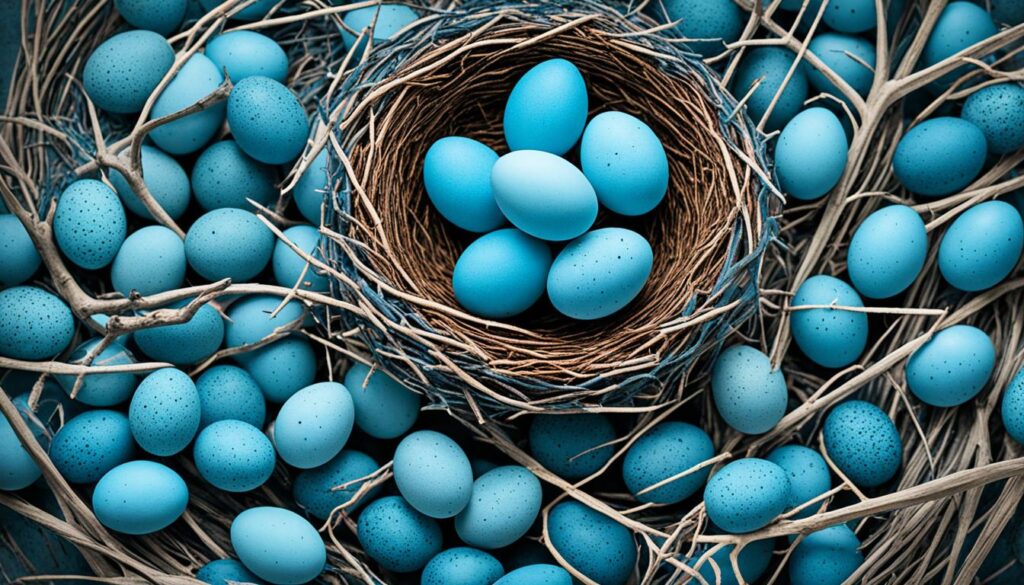
In North America, these adaptable birds have become very common. There are more than 200 million of them. Their unique blue eggs and strong breeding habits are exciting for people who love birds.
Blue Jay Eggs
The blue jay is a bright and friendly bird known for its stunning blue feathers. It’s found across North America, from pine forests to our backyards.
Incubation and Nesting
Blue jays make their nests high in trees, between 10 and 25 feet above ground. These nests are found in deciduous or coniferous trees. The female lays 2 to 7 eggs that are light blue, about 0.8 inches wide and 1.2 inches long.
She sits on these eggs for about 17 to 18 days, keeping them warm. During this time, the male finds food for her and protects the nest. Both parents work hard to care for their young, sometimes having more than one brood a season.
“Blue Jays lay a clutch of two to seven eggs, which are blueish or light brown with darker brown spots.”
In recent years, blue jays have thrived and spread their habitat. They now live from southern Canada to Florida and northeastern Texas in the United States. Their success in various environments shows their strong adaptation skills.
| Blue Jay Egg Characteristics | Measurement |
|---|---|
| Egg Width | 0.8 inches |
| Egg Length | 1.2 inches |
| Clutch Size | 2-7 eggs |
| Incubation Period | 17-18 days |
House Finch Blue-Green Eggs
The house finch is a small, lively bird that sings a lot. The males stand out with their bright red heads and chests. Yet, this bird surprises us with its beautiful blue-green eggs. They usually make their nest somewhere low, like on a ledge. The nest is a small cup made of twigs and leaves.
These eggs have a light blue-green color and sometimes with purple-brown spots. The spots can be a lot or just a few. A set of house finch eggs is about 0.6 inches wide and 0.8 inches long on average.
The female will lay 2 to 6 eggs that are pastel-colored. Then she will sit on them to keep them warm for about two weeks. House finches can have up to three sets of babies in a year. That’s why they are considered great at making a lot of babies.
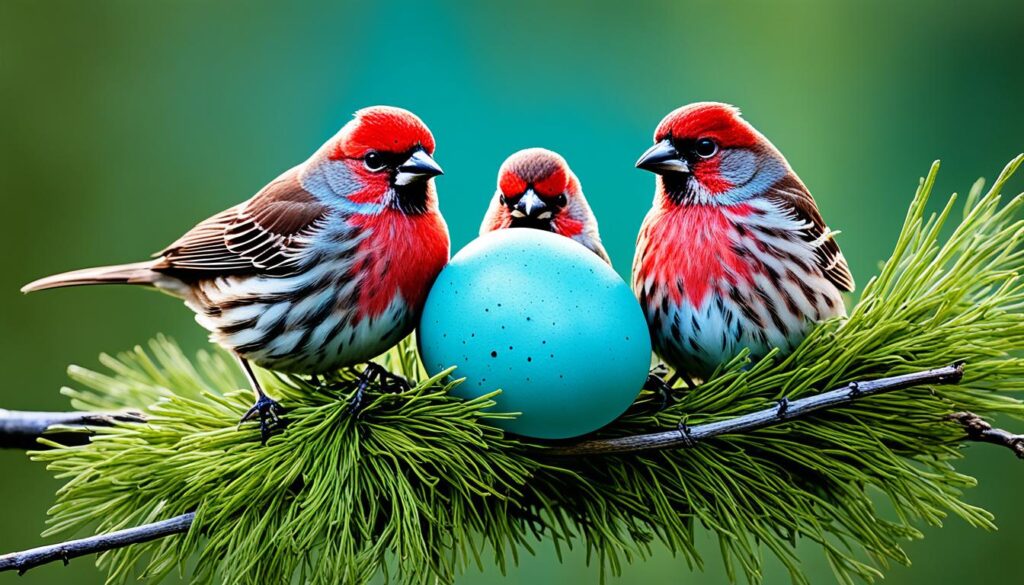
“House finches are one of the most adaptable and successful birds in North America, and their blue-green eggs are a testament to their remarkable breeding abilities.”
American Robin’s Beautiful Blue Eggs
The American robin is known for its bright blue eggs. These eggs shine beautifully in their nests, bringing nature’s beauty. They are a joy to see in any backyard.
Nest Site Selection
American robins make their nests in many places. This includes low to the ground and up high in tree branches. They often choose spots with thick leaves for protection. This keeps their american robin blue eggs safe from harm.
Multiple Broods per Season
American robins raise more than one family a year. They can care for two or three sets of eggs in the warm months. This ensures their species keeps going strong.
Watching a female robin protect her 3 to 5 eggs is amazing. These eggs are small, measuring about 0.8 by 1.2 inches. The mother keeps them warm for 12 to 14 days, almost all the time.
“Robins only abandon their eggs when they perceive poor chances of successful hatching and raising, often due to external disturbances or threats.”
The stunning american robin blue eggs show how tough and flexible these birds are. Their ability to adapt and have many families each year keeps them in our lives. They are the joyful signs of spring we all love to see.
what kind of birds lay blue eggs
Birds from different families lay blue or blue-green eggs. This includes well-known ones like the American Robin and Eastern Bluebird. Also, others like European Starlings, Blue Jays, and more. The list also features Snowy Egrets, and Green Herons.
These eggs get their blue color from a pigment called biliverdin. This pigment might help against UV rays or let birds see their own eggs better. It could also confuse predators, keeping the eggs safe.
- The Eastern Bluebird usually lays light blue eggs, up to 7 in a group. Sometimes white eggs appear.
- The American Robin lays 3 to 5 light blue eggs. They are easily recognized because of their color.
- The Eurasian Jackdaw’s eggs are pale blue to greenish-blue. It typically lays 3 to 5 eggs.
- Magpies have eggs that are blue-green with brown spots. They usually have between 3 to 5 eggs at a time.
- Emu eggs are a deep green to blue. They are about 5 inches long and 3.5 inches wide. They weigh about 1.1 pounds.
Many birds lay blue eggs. They don’t all act the same when it comes to nesting or how many eggs they have. Saving these birds and their special eggs is important. Their homes are at risk due to habitat loss and other problems.

| Bird Species | Egg Color | Egg Size (cm) | Clutch Size |
|---|---|---|---|
| Blackbird | Blue-green with brown speckles | 2.9 x 2.1 | 3-5 |
| Blue Tit | Light-cream with light brown speckles | 1.6 x 1.2 | 8-10 |
| Bullfinch | Light green-blue with purple markings | 2 x 1.5 | 4-5 |
| Carrion Crow | Pale blue-green with brown and grey markings | 4.3 x 3 | 4-7 |
| Chaffinch | Off-white with brown-red splotches | 1.9 x 1.5 | 4-5 |
This table shows the many kinds of blue and blue-green eggs birds lay. It helps us learn more about birds and their eggs.
Bluebird’s Sky Blue Eggs
The Eastern Bluebird is known for laying bright sky blue eggs. These eggs are small, about 0.8 inches wide and 0.9 inches long. The female bird sits on them for 13 to 20 days.
Nest Box Benefits
Bluebird numbers have gone up thanks to nest boxes. These boxes don’t have perches and are placed out in the open. This lets bluebirds have more babies. They can have up to three broods in a year because of these boxes. It’s made a big difference for them, giving them safe places to live and lay their unique eggs.
Most bluebird eggs are a bright blue, but sometimes a white or pink one is found. This doesn’t happen often, making it extra special when it does.
Watching Bluebirds is a joy, but they bring more than beauty. They’re important for a healthy environment because they eat lots of insects. We help them by putting up nest boxes. This supports these special birds, making sure they stay in our areas for a long time.
Blackbird Species with Blue Eggs
Most blackbirds lay dark eggs, but some stand out with blue ones. These rare blue eggs are a stunning addition to blackbird nests. We’ll look at which blackbird species lay these unique blue eggs and why.
The Red-winged Blackbird is a famous example. It lays 2 to 5 pale blue eggs. These eggs have dark patterns and colors that vary from gray to greenish-blue. They’re about 0.8 inches wide and 1.1 inches long.
The female Red-winged Blackbird sits on her eggs for 11 to 13 days. The male keeps predators away. They nest in marshes and shrubs. Sometimes, they can have up to three groups of babies in one season.
| Blackbird Species | Egg Color | Egg Size | Nesting Habitat | Broods per Season |
|---|---|---|---|---|
| Red-winged Blackbird | Pale blue, grayish, or greenish-blue | 0.8 inches wide, 1.1 inches long | Marsh vegetation, shrubby areas | Up to 3 |
Blue eggs are rare among blackbird species. Only a few produce these bright blue eggs. Most stick to dark colors. But these unique blue eggs leave a lasting impression on those who see them.
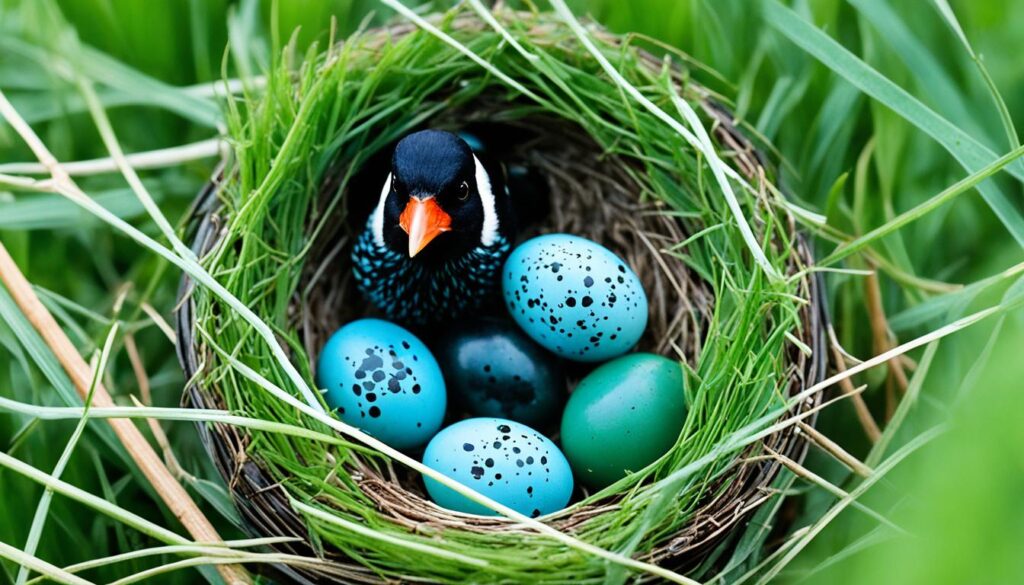
Blackbirds surprise us with their blue eggs. Their variety and behavior are fascinating. The blue eggs are just one part of the many wonders in the bird world.
Crow’s Pale Blue Eggs
Crows may not stand out with bright colors like some birds. But they lay amazing blue eggs. The American Crow is seen all over the United States. It’s recognized for its pale blue or pale green-blue eggs. These eggs are about 1.2 inches wide and long. They also have light, scattered dark speckles, making them beautiful.
The female crow sits on her 3 to 9 eggs for 16 to 18 days. During this time, her mate and others in the crow family protect them. These crows are very social. They build big nests of sticks high in trees.
Nest Protection Behavior
Protecting their nest is crucial for crows. They will fight any danger to keep their eggs and chicks safe. They alert their friends by being very noisy if threatened. This teamwork protects their unique pale blue eggs and young ones.
American Crows can be quite productive during the breeding season. They sometimes have two sets of chicks. Their bright blue eggs and good parenting make them interesting to people who love birds and nature.
| Egg Color | Egg Size | Nesting Behavior | Breeding Capacity |
|---|---|---|---|
| Pale blue or pale green-blue with faint dark speckling | Approximately 1.2 inches wide and 1.2 inches long | Bulky stick nest, usually high in a tree, with aggressive nest defense | 3 to 9 eggs per clutch, potential for two broods per season |
Wood Thrush Turquoise Eggs
Many bird species have beautiful blue eggs, but the wood thrush is special. Its eggs are a shiny turquoise-green, making them a wonder of nature. This shows how amazing these woodland songbirds are.
Wood thrushes lay 3 to 4 of these lovely eggs. Each egg is about 1 inch long and 0.75 inches wide. They play a key part in the bird’s nesting and breeding.
The female wood thrush is in charge of keeping the eggs warm. She sits on them for 11 to 13 days. She builds a nest out of twigs, leaves, and other items in a shrub or tree fork.
It’s interesting that wood thrushes often have two groups of chicks each year. This shows how they can adapt and make sure their babies survive. It helps keep these pretty birds in the wild.
“The wood thrush’s turquoise eggs are a true testament to the wonders of avian biodiversity, and their conservation is crucial in maintaining the ecological balance of our forests.”
Learning about how wood thrushes nest and breed gives us insight into bird life. It also shows the importance of saving their homes.
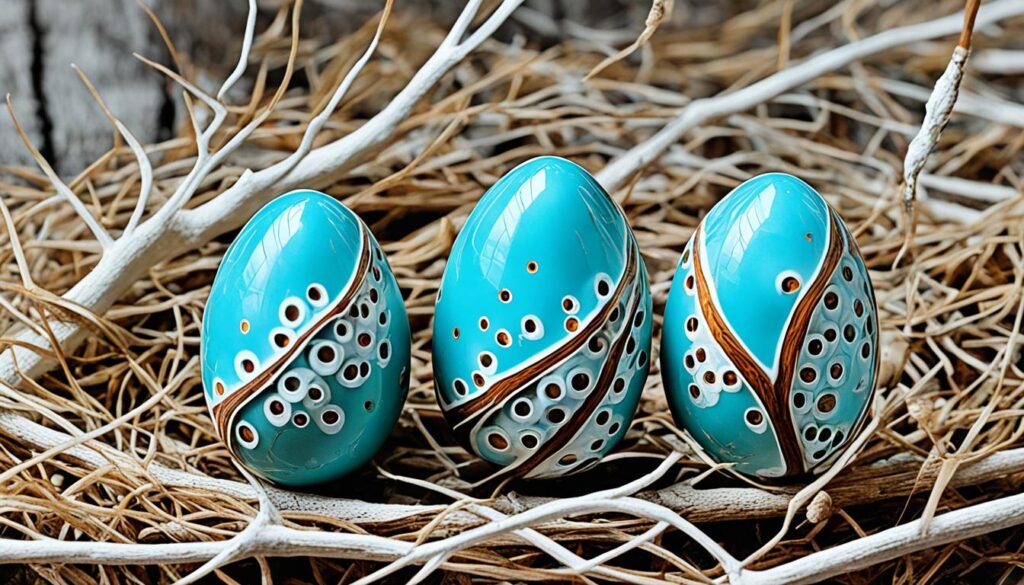
Common Grackle’s Speckled Blue Eggs
The common grackle has a unique feature. It lays blue eggs that stand out because they are speckled blue. These beautiful eggs catch the eye of anyone who loves looking at birds. They show us how interesting the breeding habits of common North American blackbirds are.
The common grackle lays between 1 to 7 of these special eggs. Each egg is about 1.12 inches long and 0.83 inches wide. They are a pale blue color with dark brown speckles and lines. Sometimes, they can be greenish-blue or gray. The pretty speckles come from a blue pigment called biliverdin.
Female grackles build messy nests with twigs, sticks, and other things like paper. Only the female grackle sits on the eggs to keep them warm. This takes about 13 days. The male might help build the nest, but the mother bird mostly takes care of the eggs and chicks.
Scientists are very interested in why the common grackle lays blue eggs. They study how often this happens. They want to learn what it tells us about how and why birds lay eggs in different colors.
Understanding the common grackle’s eggs helps us appreciate bird life more. We learn how diverse birds are in how they have babies. It also makes us curious about the amazing world of birds.
Magpie Blue-Green Eggs
The Eurasian Magpie has a striking look with its black and white feathers. It’s known for laying blue-green eggs. These eggs are around 1.36 inches long and 0.94 inches wide. Birdwatchers and nature lovers find them stunning.
The eggs are not just blue-green. They have an olive-brown speckling that makes them even more beautiful. While most blue-green eggs come from the Eurasian Magpie, some North American species also lay similar eggs. For instance, the Black-billed Magpie lays eggs that are gray or tan. On the other hand, the Yellow-billed Magpie of California has eggs with a pale greenish-blue color and speckling.
Nest Construction
Magpies are skilled at building nests. They use twigs, grass, and mud to create large, domed structures. These nests are often seen on utility poles or in tree branches. The female Magpie cares for the eggs alone. After 16 to 18 days, the eggs hatch.
Magpies’ eggs and nesting habits make them interesting to watch. The birds combine beauty with cleverness. This combo is why they are a joy for not only birdwatchers but also anyone who loves nature.
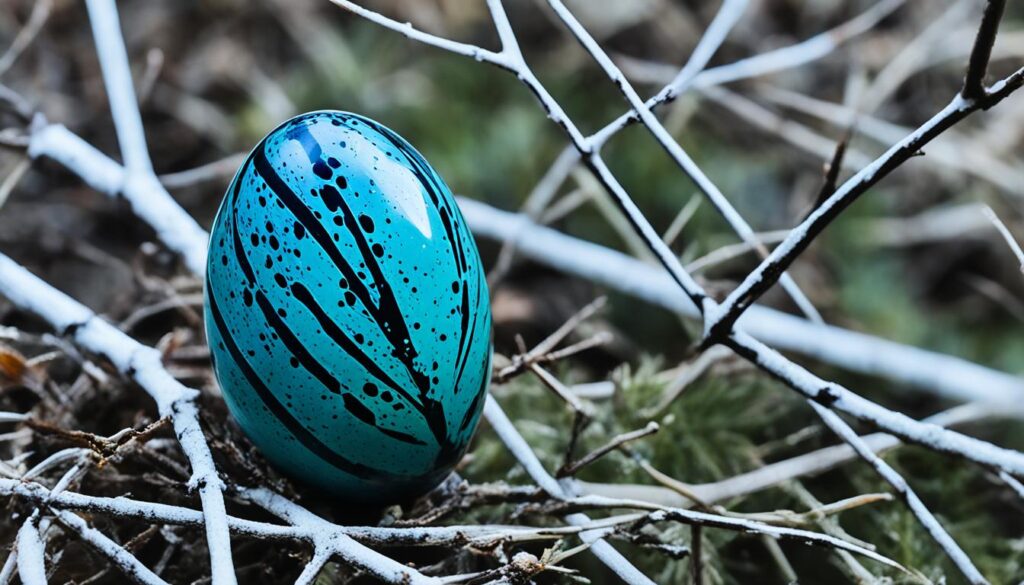
“The Magpie’s blue-green eggs are a true work of art, showcasing the beauty and diversity of the natural world.”
| Magpie Species | Egg Color | Egg Size (inches) |
|---|---|---|
| Eurasian Magpie | Blue-green with olive-brown speckling | 1.36 x 0.94 |
| Black-billed Magpie | Gray or tan | N/A |
| Yellow-billed Magpie | Pale greenish-blue with speckling | N/A |
Gray Catbird’s Beautiful Blue Eggs
The gray catbird is a captivating member of the Mimidae family. It includes birds like mockingbirds, thrashers, and tremblers. These birds are great at singing. They can make two sounds at once using different parts of their throats. Their songs can sound like other birds or even machines.
Gray catbirds lay beautiful blue eggs. They build a nest shaped like a cup out of twigs, bark, and mud. Mothers set their nests up to 10 feet high in plants like shrubs or vines. Each nest can have 3 to 5 eggs.
The catbird’s eggs are about 1 inch long and 0.6 inches wide. They come in shades from bright blue to sea-green. Sometimes, you might see tiny red spots on them. Only the female sits on the eggs to keep them warm, taking about 12-13 days. While she stays on the nest, her partner brings her food and protects the area.
These birds are very good at spotting and removing eggs that don’t belong, like those of the Brown-headed Cowbird. This helps them make sure they raise their own babies safely and without competition.
Gray catbirds live along the Atlantic coast all year round, from Massachusetts to Florida and the Gulf. They travel from places like Mexico and Central America to breed in the northern U.S. and Canada. They can have up to three sets of chicks each year.
While some see them as pests, gray catbirds are important for our environment. They eat lots of insects and berries, which is great for plants. By keeping insect numbers down, they help keep our gardens and natural areas healthy.
Dunnock’s Sky Blue Eggs
The dunnock, a small bird, is part of the Accentor family. It’s famous for its dunnock blue eggs. These eggs, in shades of sky-blue or pale blue, are incredibly beautiful. They add a natural charm to the bird world. Dunnock eggs are, on average, 0.74 inches long and 0.55 inches wide.
This bird breeds a lot, raising up to three sets of young ones every year. It usually lays 3 to 6 eggs. The eggs are placed in a nest made of moss, twigs, and soft hair. The mom bird keeps the eggs warm for about 12 to 13 days. This effort helps the baby birds grow strong and healthy.
Dunnocks live all across Europe. People have studied a lot about their nesting and breeding habits. They found that dunnock eggs can be slightly different in color and size. But, the bright and beautiful sky-blue eggs are the most common.
“The dunnock’s sky-blue eggs are a true marvel of nature, a testament to the diversity and beauty of the avian world.”
The dunnock bird is important for the environment. By learning about their bright blue eggs and how they breed, we learn about the circle of life. It shows us the value of taking care of these amazing birds.
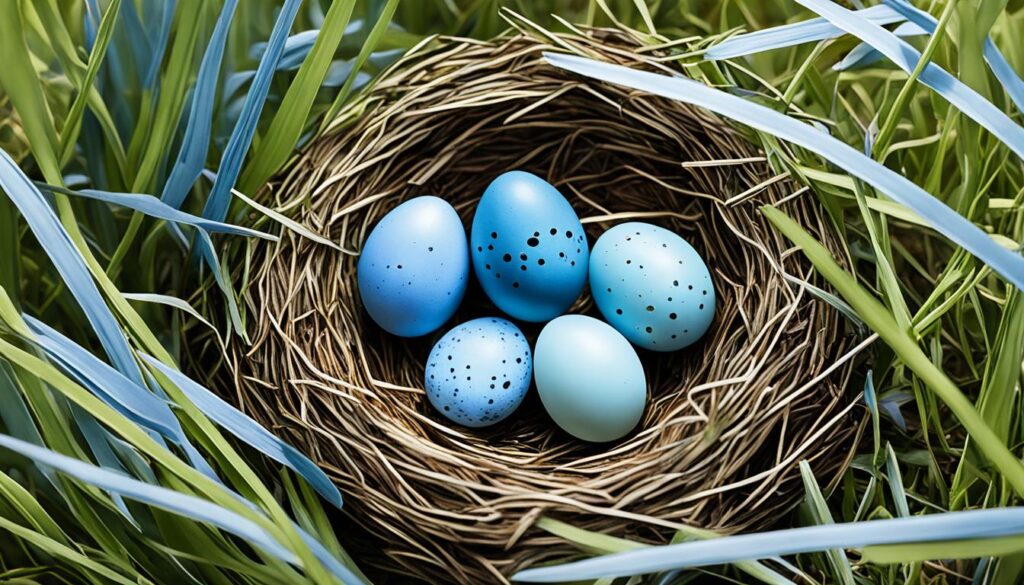
Snowy Egret’s Pale Blue Eggs
The snowy egret is famous for its white feathers and long, slender legs. But did you know they lay pale blue eggs? Normally, they lay 3 to 4 of these eggs. Each one is about 1.3 inches wide and 1.7 inches long.
These eggs are a light greenish-blue. Sometimes, they might even look white. The female egret builds the nest. It’s a big nest made of sticks and it’s high up in a tree. These nests are often near water, in swamps or wetlands.
Both parents take turns keeping the eggs warm for about 24 to 25 days. When the chicks hatch, both parents feed and care for them. This is done every year, with only one group of chicks. The color of the eggs isn’t just beautiful. It also helps keep the eggs warm and hidden, keeping them safe.
| Egg Characteristics | Nesting and Breeding |
|---|---|
|
|
Looking at the snowy egret’s egg color and size tells us a lot. It can tell us how well these birds are doing. Through learning about their snowy egret nesting and breeding, we help protect them. And by protecting them, we protect the places where they live, like wetlands.
Green Heron’s Pale Sky Blue Eggs
The green heron is known for its beautiful, pale sky blue eggs. It’s a small bird that lives in wetlands. They typically lay 2 to 6 eggs in a nest that looks like a shallow cup.
The male and female both take care of the eggs for about 3 weeks. They choose to build their nests in shrubs or trees near water. The male helps build the nest, but the female does most of the work.
Green herons can have two sets of chicks in one season. This helps the species survive and thrive. It’s an interesting way they use resources wisely.
| Egg Characteristics | Nest and Breeding Details |
|---|---|
|
|
The way green herons nest and raise their young is truly interesting. Their blue eggs are a wonder of nature. It shows how amazing birds can be.
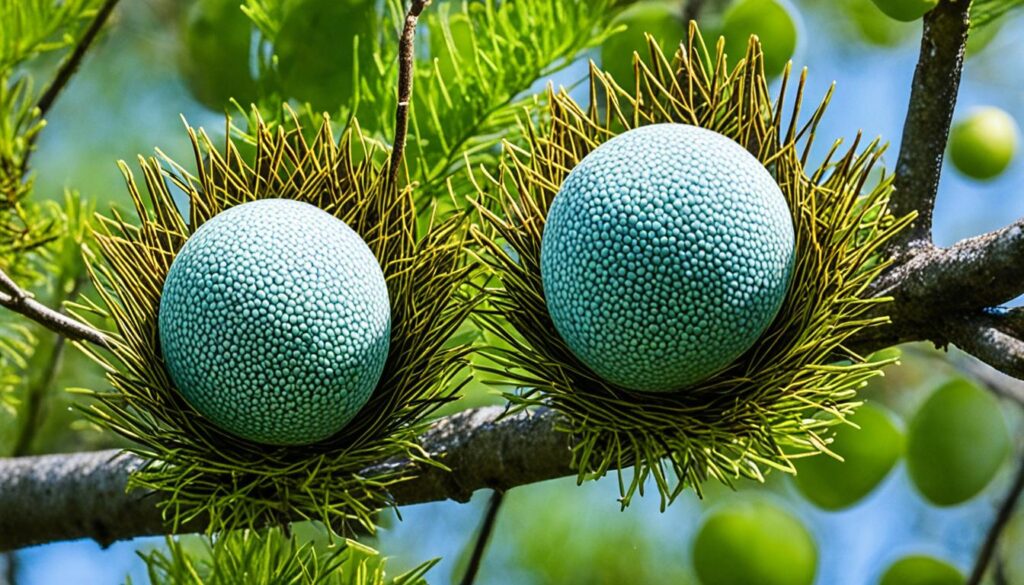
Conclusion
Blue eggs are something special, seen in many bird families. Birds like the American Robin and Eastern Bluebird lay them. These eggs have benefits like protecting the baby bird from the sun and fooling enemies. They also help birds know their eggs.
This guide showed you the world of blue egg-laying birds. It talked about their types, where they nest, and why blue eggs matter. Learning about these birds helps us keep them safe and value nature’s beauty.
Blue eggs are a unique trait in a few bird kinds. They not only serve a function but also make the bird world stunning. With more study and care, we can help these birds live on. So, their blue eggs will continue to amaze us over time.
FAQ
What kinds of birds lay blue eggs?
Many bird types lay blue or blue-green eggs. Examples are American Robins and Eastern Bluebirds. Also included are European Starlings, Blue Jays, and more like House Finches. You’ll even see it in Crows and Grackles, among others.
Why do birds lay blue eggs?
Birds lay blue eggs thanks to a pigment. This pigment is from bile and is called biliverdin. The blue color serves a few purposes.
It can stop UV rays from harming the egg. It might also confuse predators. Plus, it helps birds know which eggs are theirs.
How do birds make their eggs blue?
Biliverdin is the key. It’s the pigment that creates the blue color. Birds deposit this pigment just before laying the egg. This makes the eggshells turn different shades of blue.
What are the different types of blue egg laying birds?
There’s quite a variety of birds that lay blue eggs. For instance, American Robins and Eastern Bluebirds. You also have European Starlings, Blue Jays, and Blackbirds. Even Crows and Grackles lay blue eggs.
What is the purpose of blue eggs in birds?
Blue eggs have multiple benefits. They can protect the baby bird from the sun’s UV rays. They might also confuse animals that want to eat the eggs. And they help the bird parents find their own eggs.
What are the benefits of blue eggs for birds?
Blue eggs bring many advantages to birds. They shield the baby bird from UV light. They can also trick predators and aid in egg identification. All of this helps in ensuring a bird’s offspring safety.
How do bluebirds’ sky blue eggs differ from other blue eggs?
Bluebirds stand out by laying 4 to 5 sky blue eggs. They usually nest in tree cavities or boxes. These eggs are generally pure blue. But sometimes, a nest might have a white or even pale pink egg.
How do the blue eggs of different bird species compare in size and appearance?
Blue eggs come in different sizes and shades, depending on the bird species. Consider European Starlings, whose eggs are 0.8 by 1.2 inches. Compare this to American Robins, which also lay 0.8 by 1.2 inch eggs. The shades of blue vary from very light to strikingly deep. Some eggs even have tiny speckles or other markings.
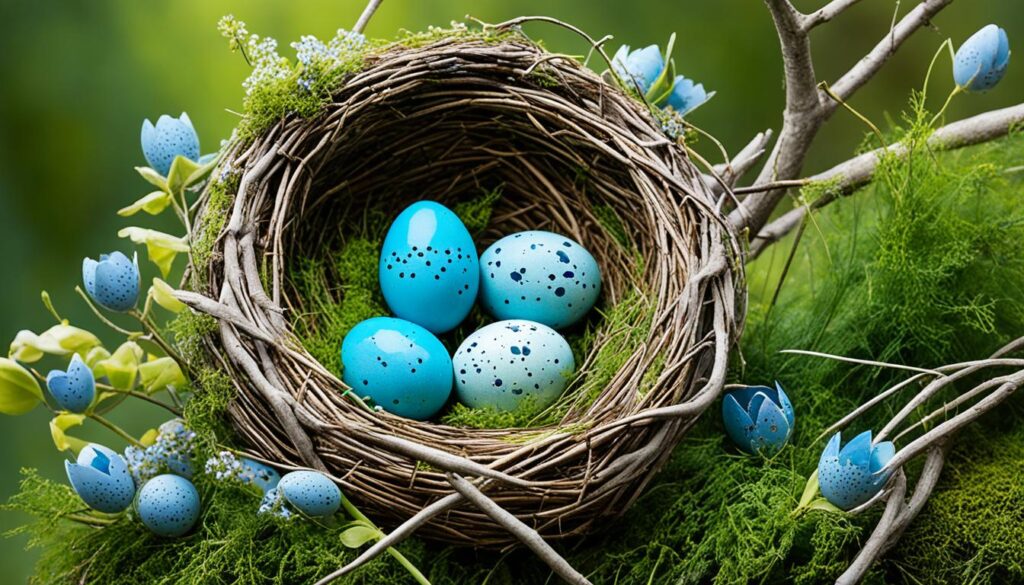

I am sure this paragraph has touched all the internet
viewers, its really really nice paragraph on building up new webpage.
my web page … nordvpn coupons inspiresensation
350fairfax nordvpn cashback
I could not refrain from commenting. Well written!